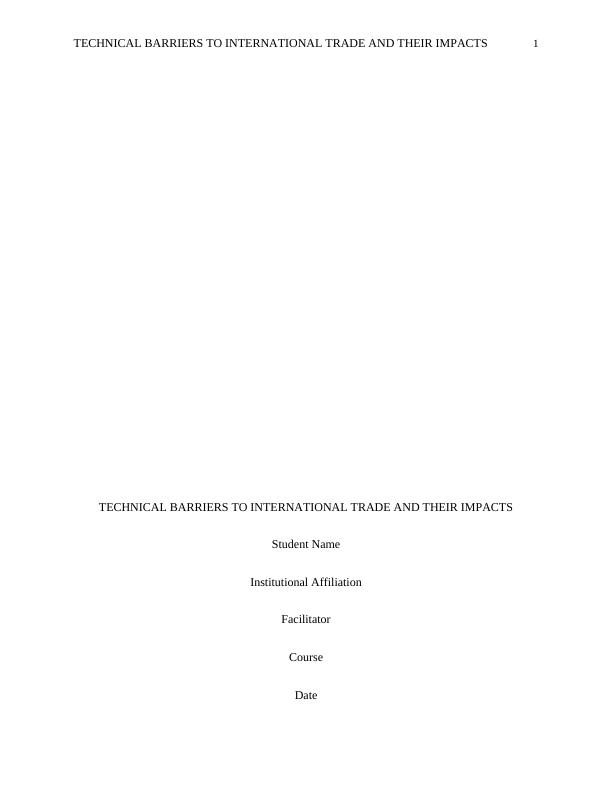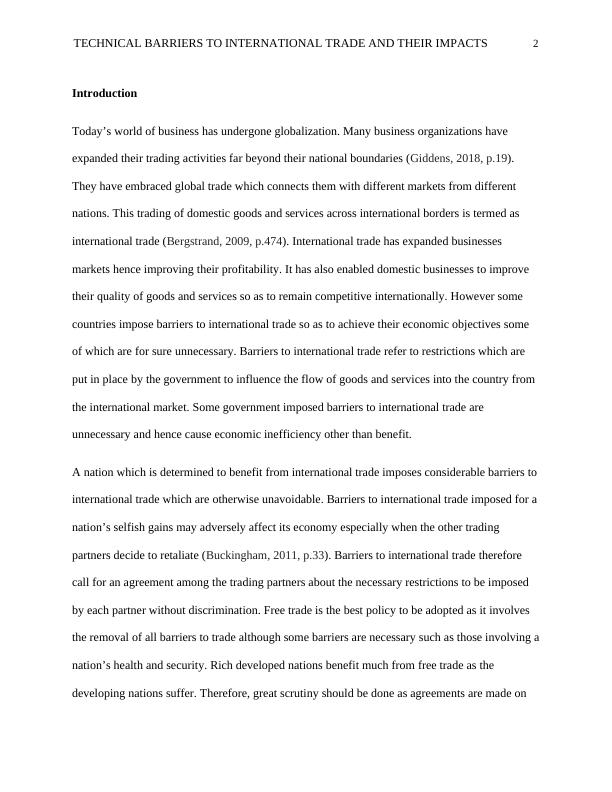Technical Barriers to International Trade and Their Impacts
Added on 2023-06-05
13 Pages3318 Words303 Views
TECHNICAL BARRIERS TO INTERNATIONAL TRADE AND THEIR IMPACTS 1
TECHNICAL BARRIERS TO INTERNATIONAL TRADE AND THEIR IMPACTS
Student Name
Institutional Affiliation
Facilitator
Course
Date
TECHNICAL BARRIERS TO INTERNATIONAL TRADE AND THEIR IMPACTS
Student Name
Institutional Affiliation
Facilitator
Course
Date

TECHNICAL BARRIERS TO INTERNATIONAL TRADE AND THEIR IMPACTS 2
Introduction
Today’s world of business has undergone globalization. Many business organizations have
expanded their trading activities far beyond their national boundaries (Giddens, 2018, p.19).
They have embraced global trade which connects them with different markets from different
nations. This trading of domestic goods and services across international borders is termed as
international trade (Bergstrand, 2009, p.474). International trade has expanded businesses
markets hence improving their profitability. It has also enabled domestic businesses to improve
their quality of goods and services so as to remain competitive internationally. However some
countries impose barriers to international trade so as to achieve their economic objectives some
of which are for sure unnecessary. Barriers to international trade refer to restrictions which are
put in place by the government to influence the flow of goods and services into the country from
the international market. Some government imposed barriers to international trade are
unnecessary and hence cause economic inefficiency other than benefit.
A nation which is determined to benefit from international trade imposes considerable barriers to
international trade which are otherwise unavoidable. Barriers to international trade imposed for a
nation’s selfish gains may adversely affect its economy especially when the other trading
partners decide to retaliate (Buckingham, 2011, p.33). Barriers to international trade therefore
call for an agreement among the trading partners about the necessary restrictions to be imposed
by each partner without discrimination. Free trade is the best policy to be adopted as it involves
the removal of all barriers to trade although some barriers are necessary such as those involving a
nation’s health and security. Rich developed nations benefit much from free trade as the
developing nations suffer. Therefore, great scrutiny should be done as agreements are made on
Introduction
Today’s world of business has undergone globalization. Many business organizations have
expanded their trading activities far beyond their national boundaries (Giddens, 2018, p.19).
They have embraced global trade which connects them with different markets from different
nations. This trading of domestic goods and services across international borders is termed as
international trade (Bergstrand, 2009, p.474). International trade has expanded businesses
markets hence improving their profitability. It has also enabled domestic businesses to improve
their quality of goods and services so as to remain competitive internationally. However some
countries impose barriers to international trade so as to achieve their economic objectives some
of which are for sure unnecessary. Barriers to international trade refer to restrictions which are
put in place by the government to influence the flow of goods and services into the country from
the international market. Some government imposed barriers to international trade are
unnecessary and hence cause economic inefficiency other than benefit.
A nation which is determined to benefit from international trade imposes considerable barriers to
international trade which are otherwise unavoidable. Barriers to international trade imposed for a
nation’s selfish gains may adversely affect its economy especially when the other trading
partners decide to retaliate (Buckingham, 2011, p.33). Barriers to international trade therefore
call for an agreement among the trading partners about the necessary restrictions to be imposed
by each partner without discrimination. Free trade is the best policy to be adopted as it involves
the removal of all barriers to trade although some barriers are necessary such as those involving a
nation’s health and security. Rich developed nations benefit much from free trade as the
developing nations suffer. Therefore, great scrutiny should be done as agreements are made on

TECHNICAL BARRIERS TO INTERNATIONAL TRADE AND THEIR IMPACTS 3
restrictions to be imposed by trading partners to ensure equality among all the trading partners
(Samuelson, 2012, p.163).
Common types of barriers to international trade
There are several restrictions on international trade which are imposed by various globally
trading partners with the aim of achieving their set economic goals (Bai, Chong, Yingjuan,
Zhigang Tao & Sarah Tong, 2014, p.397). These restrictions control the exports and imports of a
country. Most of the imposed restrictions are set to improve the domestic economy. They
include:
i. Tariffs
Tariffs refer to duties or rather taxes which are imposed on goods which enter a country
(imports) (Grubert & Mutti, 2011, p.285). They can be used to protect the domestic economy by
discouraging foreign traders from entering a country’s market. Some of the developing countries
have been imposing high tariffs on foreign traders from developing countries in a bid to protect
their domestic businesses little do they know the future repercussions. Tariffs can be protective
or revenue based. Protective tariffs are set high and their main aim is to protect a country’s
domestic economy. Revenue based tariffs are not so high and their main aim is to raise revenue
for a given imposing country.
ii. Import licenses
An import license is a document that is issued by a country’s government authorizing the imports
into the country (Krishna, 2010, p.2545). It specifies the amount of imports to be imported
whereby the specified amount should not be exceeded. Import licenses are issued at a
restrictions to be imposed by trading partners to ensure equality among all the trading partners
(Samuelson, 2012, p.163).
Common types of barriers to international trade
There are several restrictions on international trade which are imposed by various globally
trading partners with the aim of achieving their set economic goals (Bai, Chong, Yingjuan,
Zhigang Tao & Sarah Tong, 2014, p.397). These restrictions control the exports and imports of a
country. Most of the imposed restrictions are set to improve the domestic economy. They
include:
i. Tariffs
Tariffs refer to duties or rather taxes which are imposed on goods which enter a country
(imports) (Grubert & Mutti, 2011, p.285). They can be used to protect the domestic economy by
discouraging foreign traders from entering a country’s market. Some of the developing countries
have been imposing high tariffs on foreign traders from developing countries in a bid to protect
their domestic businesses little do they know the future repercussions. Tariffs can be protective
or revenue based. Protective tariffs are set high and their main aim is to protect a country’s
domestic economy. Revenue based tariffs are not so high and their main aim is to raise revenue
for a given imposing country.
ii. Import licenses
An import license is a document that is issued by a country’s government authorizing the imports
into the country (Krishna, 2010, p.2545). It specifies the amount of imports to be imported
whereby the specified amount should not be exceeded. Import licenses are issued at a

TECHNICAL BARRIERS TO INTERNATIONAL TRADE AND THEIR IMPACTS 4
competitive price and to some extent corruption and bribery is involved in the process. Some
countries, mostly the developing ones offer import licenses at a higher price, or even complicate
the issuance process of the licenses in order to discourage the entry of foreign goods into the
country and hence encourage the consumption of domestically produced goods.
iii. Quotas
Quotas refer to restrictions put in place by the government in order to control the exports and
imports in a given country (Tripp & Kang, 2009, p.338). Most quotas aim at protecting a
country’s domestic economy by reducing the amount of imports entering the country. Some
countries more so the developing ones restrict the amount of exports and imports to encourage
the consumption of locally produced goods and hence improve their economy.
iv. Subsidies
Subsidization refers to financial or any form of support either from the government or non-
governmental organizations to economic sectors within the country (Poterba, 2014, p.729).
Subsidization enables cheaper production of goods and services by producers in the economy.
Cheaper production means that domestic goods will be sold at cheaper prices compared to
foreign goods. As a result consumers opt for domestic goods and hence the market of the foreign
goods decreases forcing foreigners to exit the country’s market.
v. Embargo
This refers to a situation whereby the government of a certain country partially or completely
bans trading activities with another country (Andreas, 2015, p.335). This can be used for
domestic or international purposes. It may be aimed at controlling a country’s political climate or
competitive price and to some extent corruption and bribery is involved in the process. Some
countries, mostly the developing ones offer import licenses at a higher price, or even complicate
the issuance process of the licenses in order to discourage the entry of foreign goods into the
country and hence encourage the consumption of domestically produced goods.
iii. Quotas
Quotas refer to restrictions put in place by the government in order to control the exports and
imports in a given country (Tripp & Kang, 2009, p.338). Most quotas aim at protecting a
country’s domestic economy by reducing the amount of imports entering the country. Some
countries more so the developing ones restrict the amount of exports and imports to encourage
the consumption of locally produced goods and hence improve their economy.
iv. Subsidies
Subsidization refers to financial or any form of support either from the government or non-
governmental organizations to economic sectors within the country (Poterba, 2014, p.729).
Subsidization enables cheaper production of goods and services by producers in the economy.
Cheaper production means that domestic goods will be sold at cheaper prices compared to
foreign goods. As a result consumers opt for domestic goods and hence the market of the foreign
goods decreases forcing foreigners to exit the country’s market.
v. Embargo
This refers to a situation whereby the government of a certain country partially or completely
bans trading activities with another country (Andreas, 2015, p.335). This can be used for
domestic or international purposes. It may be aimed at controlling a country’s political climate or

End of preview
Want to access all the pages? Upload your documents or become a member.
Related Documents
Trade Barriers: Effects on Growth and Development of Countrieslg...
|6
|1397
|323
Tariffs and Import Duties- Effects on Industries and Other Economies, Costs and Benefits of a Tarifflg...
|13
|3673
|475
Trade Protectionism and Its Effects on the US Economylg...
|6
|1113
|305
Importance of Protectionism in Domestic Marketlg...
|7
|1654
|384
The 13th biggest economy in the worldlg...
|11
|2173
|208
The Role of Government Protectionism in Economic Growth and Business Activitieslg...
|8
|1510
|14